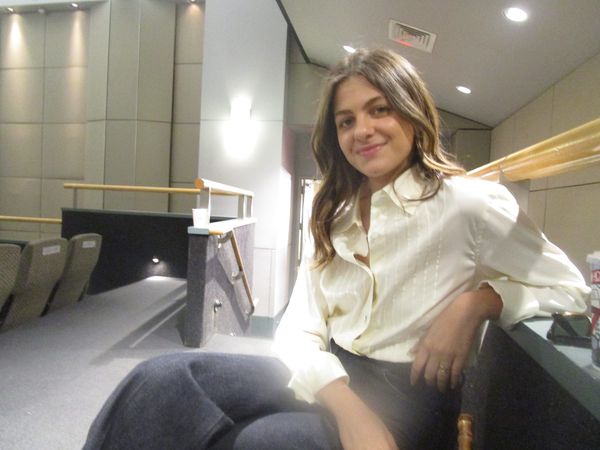 |
| Margherita Mazzucco on the connection with Saverio Costanzo, Susanna Nicchiarelli, and Chiara: “I was shooting My Brilliant Friend and I received this call from Susanna …” Photo: Anne-Katrin Titze |
Susanna Nicchiarelli’s Chiara, starring Margherita Mazzucco (of Saverio Costanzo’s My Brilliant Friend fame, with Alba Rohrwacher playing the same character in his Elena Ferrante adaptation) was a highlight of
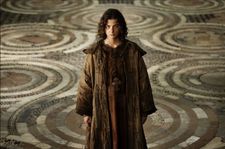 |
| Margherita Mazzucco as Chiara: “She did these incredible things by herself and I’m very happy to portray this character.” |
Chiara, St. Clare of Assisi (played with vigour and poise by Mazzucco), a disciple of St. Francis of Assisi (Andrea Carpenzano), is front and centre in Nicchiarelli’s take on what it could have meant to be a woman in the 13th Century, who wanted to express her beliefs but didn’t want to be a saint. The year is 1211 and women have to fight for their right to live in poverty and chastity. The monastery at the time is a refuge to avoid being married to men, some 50 years their senior. Chiara who stems from a wealthy family stops her uncle from killing her sister with a stone because she refuses to marry 70-year-old Alfredo.
When we first see Chiara, together with her friend Pacifica (Flaminia Mancin) run away at night to join St. Francis, it has the feel of a children’s game. What if the devil were behind them, they joke. Soon it is Francis himself, who appears less than perfect. Nicchiarelli provides a new reading of him and his weakness, while exploring Chiara’s accomplishments which were mostly forgotten in histories written by men.
Chiara elegantly straddles the realm of the supernatural, and it is precisely the mix of the explainable and the unexplained that has the greatest effect. One boy who has a pebble stuck in his nose is miraculously healed by Chiara pulling it out with a pair of pincers. When fellow nun Balvina (Paola Tiziana Cruciani) is close to dying, she recovers after Chiara’s care.
 |
| Margherita Mazzucco on Susanna Nicchiarelli: “I read the script and I thought this story was so beautiful.” Photo: Anne-Katrin Titze |
A golden plate functions as a visual halo and bright green olive oil and endless bread are nourishment and divine gift. We see Chiara’s skin clear as she fights to be able to preach to the sisters in a language they can understand and not in the Latin that keeps the power dynamics in check. They dance to the sun and embrace the smile of the universe, while Chiara is battling the Pope’s edict, a result of clearly deeming her too dangerous.
“Your illness and suffering are a path to eternal life,” Chiara tells the crying Francis. Pope Gregorio IX (Luigi Lo Cascio in great form) whom she knew since he was a mere Cardinal, is fed dish after extravagant dish while the convent is starving. St. Francis has been dead for two years and she wants to write an official rule. Bribery, she learned, is part of the game.
From inside the Walter Reade Theater at Lincoln Center the morning after the Open Roads: New Italian Cinema Opening Night screening of Francesca Archibugi’s The Hummingbird (Il Colibrì), Margherita Mazzucco sat with me for a conversation on Chiara.
Anne-Katrin Titze: How are you?
Margherita Mazzucco: I’m excited! It’s my first time here in New York.
AKT: I loved your performance in Chiara.
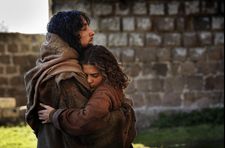 |
| St. Francis (Andrea Carpenzano) with Chiara (Margherita Mazzucco) |
MM: Thank you!
AKT: And also in My Brilliant Friend. Tell me how Chiara came about, how Susanna found you! Did she see you in My Brilliant Friend?
MM: Yes! I was shooting My Brilliant Friend and I received this call from Susanna and she told me “I saw you in My Brilliant Friend and I think you’re perfect for Chiara. Do you want to do an audition? I will send you the script.” I didn’t know the story of Chiara. I knew the story of St. Francesco because we studied it in school. I read the script and I thought this story was so beautiful. So I did audition and it went well.
AKT: Did you see Susanna’s Nico, 1988 film?
MM: I saw Nico after.
AKT: After you got the part?
MM: Yes! Also Miss Marx and I really liked them. Because Susanna told me it was like a trilogy and these are three very powerful women. Very different, but they have this strength in common.
AKT: Have you seen Bruno Dumont’s films about Joan of Arc?
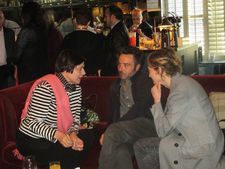 |
| Isabella Rossellini captivates Saverio Costanzo and Alba Rohrwacher Photo: Anne-Katrin Titze |
MM: No, I haven’t.
AKT: French films, that reminded me a bit of the staging of Chiara. People know St. Frances and mostly know nothing about Chiara whose story is fascinating.
MM: Yes, it’s strange because she was so important for the time. She did an incredible thing and was so ahead of her time. I don’t know why no one talks about her. And also they talk about her in the wrong way because they think she was only behind Francesco, that she was this little girl who was praying all the time, but she wasn’t like that. She did these incredible things by herself and I’m very happy to portray this character.
AKT: It’s great how on the one hand she is maybe performing miracles, but on the other, she does things like pulling a pebble out of a nose. I love the mix in the film, the fact that we don’t know if her healing is a miracle or not.
MM: Yeah, I think this was one of the most important things in the movie, something we talked about a lot. These miracles - we didn’t know how to shoot them. Susanna told us either one has to be like magic, but it’s something that God does through the saint. So it’s not a thing that Chiara does, it’s something God does.
AKT: Through her!
 |
| Margherita Mazzucco with Anne-Katrin Titze: “ I had like ten days to learn three songs, three dances and that was really fun.” Photo: Anne-Katrin Titze |
MM: Yes. So she’s frightened about that and she is surprised. Also people are frightened by that and she doesn’t want that because she wanted to be with the people and not …
AKT: A saint! She wants to be equal to the people.
MM: Yes, she doesn’t want to scare people.
AKT: The scenes with the Pope are very funny too, also the dance sequences. Did you also have fun shooting these?
MM: I had like ten days to learn three songs, three dances and that was really fun, because we were all together, we were dancing barefoot in this big church. That was fun. And I think the scenes with the Pope were my favourite, also because there are two of them and they were very different. One of them is in the middle of the film and Chiara was younger and a little bit scared, but also very brave. At the end of the film she’s very calm and firm and she does compromise with the Pope, because she’s also an adult now. She has a lot of responsibilities. I really liked that.
AKT: The shift, the movement - and she wants to write a rule, she wants to be proactive. The film also shows how much hers was a place of refuge for women. The moments with the little sister being married off to a 70-year-old man!
MM: Paradoxically it was like freedom for them to be in closure. Because they had to marry older men and to be in that movement was an act of freedom. They are free to walk in the streets to back people, to be barefoot. That was very strong for the time.
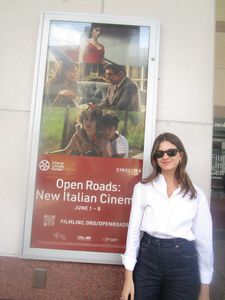 |
| Open Roads: New Italian Cinema poster with Margherita Mazzucco Photo: Anne-Katrin Titze |
AKT: The will to fight for their poverty and chastity is also very interesting. It’s such a reversal of what is usually desired today. The contagion, of course, when they come to the aid of people with a plague going on - Covid is on everybody’s mind. These scenes would have read differently, had this film been made before the pandemic.
MM: It was made after COVID and during. We took temperature every day and had masks on. That scene reminds me of it because we had these scarves on. They are not afraid, though, they go and help people. They want to be with the people. It’s very human and generous.
AKT: What is coming up for you?
MM: I’m very superstitious so I don’t usually talk about this, but I want to choose something beautiful. I had the opportunity to play two beautiful characters who are very strong and I want to continue on this line.
AKT: Saverio is such a great director and so is Susanna. So you definitely worked with two beautiful directors who make great films! Thank you so much!
MM: Thank you!





















